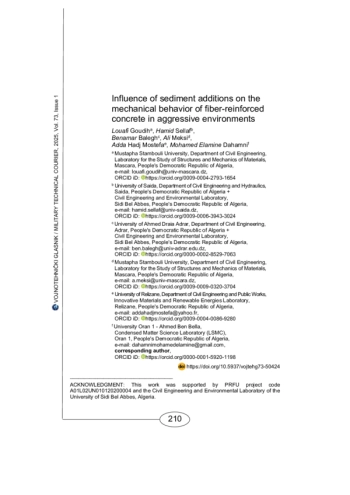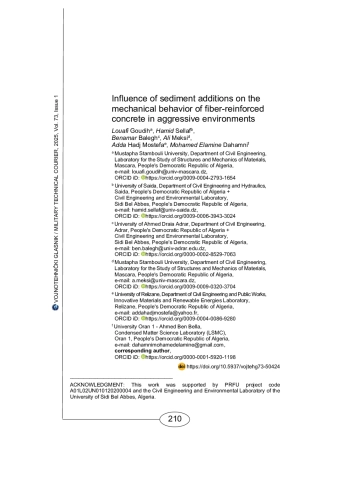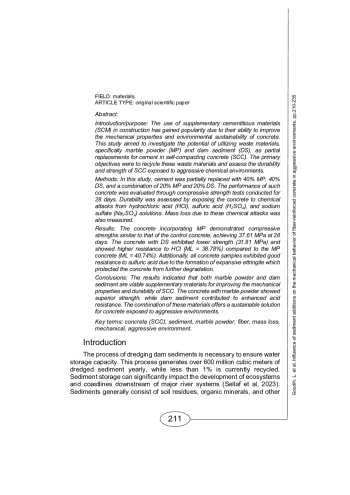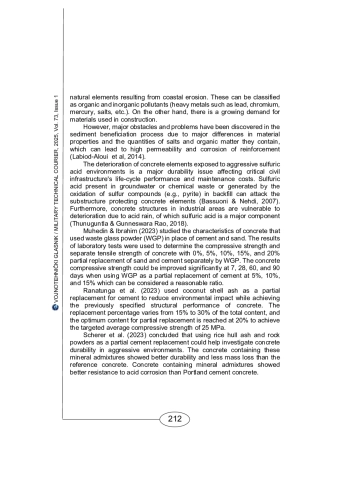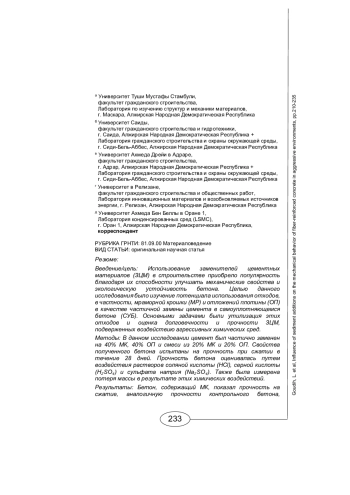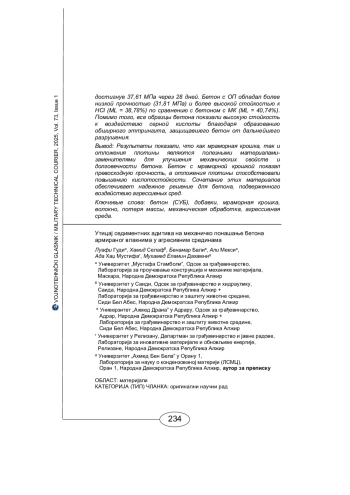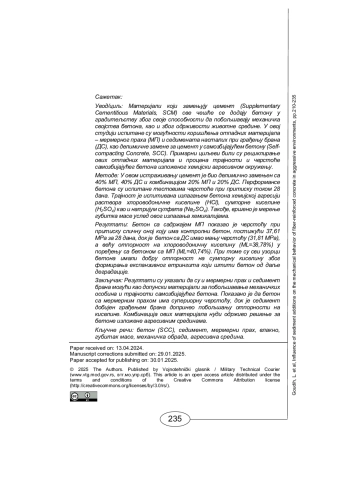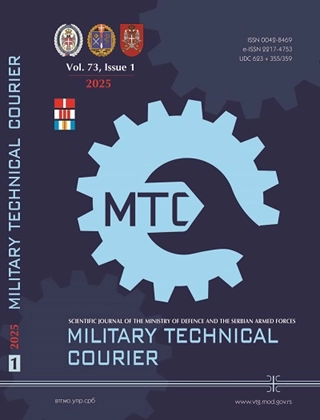Introduction/purpose: The use of supplementary cementitious materials (SCM) in construction has gained popularity due to their ability to improve the mechanical properties and environmental sustainability of concrete. This study aimed to investigate the potential of utilizing waste materials, specifically marble powder (MP) and dam sediment (DS), as partial replacements for cement in self-compacting concrete (SCC). The primary objectives were to recycle these waste materials and assess the durability and strength of SCC exposed to aggressive chemical environments.
Methods: In this study, cement was partially replaced with 40% MP, 40% DS, and a combination of 20% MP and 20% DS. The performance of such concrete was evaluated through compressive strength tests conducted for 28 days. Durability was assessed by exposing the concrete to chemical attacks from hydrochloric acid (HCl), sulfuric acid (H₂SO₄), and sodium sulfate (Na₂SO₄) solutions. Mass loss due to these chemical attacks was also measured.
Results: The concrete incorporating MP demonstrated compressive strengths similar to that of the control concrete, achieving 37.61 MPa at 28 days. The concrete with DS exhibited lower strength (31.81 MPa) and showed higher resistance to HCl (ML = 38.78%) compared to the MP concrete (ML = 40.74%). Additionally, all concrete samples exhibited good resistance to sulfuric acid due to the formation of expansive ettringite which protected the concrete from further degradation.
Conclusions: The results indicated that both marble powder and dam sediment are viable supplementary materials for improving the mechanical properties and durability of SCC. The concrete with marble powder showed superior strength, while dam sediment contributed to enhanced acid resistance. The combination of these materials offers a sustainable solution for concrete exposed to aggressive environments.
Идентификаторы и классификаторы
The process of dredging dam sediments is necessary to ensure water storage capacity. This process generates over 600 million cubic meters of dredged sediment yearly, while less than 1% is currently recycled. Sediment storage can significantly impact the development of ecosystems and coastlines downstream of major river systems (Sellaf et al, 2023).
Список литературы
1. -ACI Committee 237. 2007. 237R-07: Self-Consolidating Concrete. ACI American Concrete Institute, January 4 [online]. Available at: https://www.concrete.org/publications/internationalconcreteabstractsportal/m/details/id/18605?gad_source=1&gclid=CjwKCAiA6aW6BhBqEiwA6KzDc9agd-Q_3KklxCQYzmj-fIVB06rtwGVxavJ-pElLHf1cHJYAaPr6tRoCdCAQAvD_BwE [Accessed: 12 April 2024].
2. -AFNOR Association française de normalisation. 1991. NF P94-054: Sols: reconnaissances et essais - Détermination de la masse volumique des particules solides des sols - Méthode du pycnomètre à eau [online]. Available at: https://www.boutique.afnor.org/fr-fr/norme/nf-p94054/sols-reconnaissance-et-essais-determination-de-la-masse-volumique-des-parti/fa020767/11077 [Accessed: 12 April 2024].
3. -AFNOR Association française de normalisation. 1992. NF P94-057: Sols: reconnaissance et essais - Analyse granulométrique des sols - Méthode par sédimentation [online]. Available at: https://www.boutique.afnor.org/fr-fr/norme/nf-p94057/sols-reconnaissance-et-essais-analyse-granulometrique-des-sols-methode-par-/fa020768/11074 [Accessed: 12 April 2024].
4. -AFNOR Association française de normalisation. 1993. NF P94-051: Sols: reconnaissance et essais - Détermination des limites d’Atterberg - Limite de liquidité à la coupelle - Limite de plasticité au rouleau [online]. Available at: https://www.boutique.afnor.org/fr-fr/norme/nf-p94051/sols-reconnaissance-et-essais-determination-des-limites-datterberg-limite-d/fa020765/11080 [Accessed: 12 April 2024].
5. -AFNOR Association française de normalisation. 1996. NF P94-056: Sols: reconnaissance et essais - Analyse granulométrique - Méthode par tamisage à sec après lavage [online]. Available at: https://www.boutique.afnor.org/fr-fr/norme/nf-p94056/sols-reconnaissance-et-essais-analyse-granulometrique-methode-par-tamisage-/fa026936/11075 [Accessed: 12 April 2024].
6. -AFNOR Association française de normalisation. 1998a. NF EN 1744-1: Essais pour déterminer les propriétés chimiques des granulats - Partie 1: analyse chimique [online]. Available at: https://www.boutique.afnor.org/fr-fr/norme/nf-en-17441/essais-pour-determiner-les-proprietes-chimiques-des-granulats-partie-1-anal/fa039721/62422 [Accessed: 12 April 2024].
7. -AFNOR Association française de normalisation. 1998b. NF P94-068: Sols: reconnaissance et essais - Mesure de la capacité d’adsorption de bleu de méthylène d’un sol ou d’un matériau rocheux - Détermination de la valeur de bleu de méthylène d’un sol ou d’un matériau rocheux par l’essai à la tache [online]. Available at: https://www.boutique.afnor.org/fr-fr/norme/nf-p94068/sols-reconnaissance-et-essais-mesure-de-la-capacite-dadsorption-de-bleu-de-/fa043689/394 [Accessed: 29 March 2024].
8. -AFNOR Association française de normalisation. 2004. NF EN 206-1: Concrete - Part 1: specification, performance, production and conformity [online]. Available at: https://www.boutique.afnor.org/en-gb/standard/nf-en-2061/concrete-part-1-specification-performance-production-and-conformity/fa125184/22922 [Accessed: 12 April 2024].
9. -AFNOR Association française de normalisation. 2010a. NF EN 12350-10: Essai pour béton frais - Partie 10: béton auto-plaçant - Essai à la boîte en L [online]. Available at: https://www.boutique.afnor.org/fr-fr/norme/nf-en-1235010/essai-pour-beton-frais-partie-10-beton-autoplacant-essai-a-la-boite-en-l/fa165666/36401 [Accessed: 12 April 2024].
10. -AFNOR Association française de normalisation. 2010b. NF EN 12350-11: Essai pour béton frais - Partie 11: béton auto-plaçant - Essai de stabilité au tamis [online]. Available at: https://www.boutique.afnor.org/fr-fr/norme/nf-en-1235011/essai-pour-beton-frais-partie-11-beton-autoplacant-essai-de-stabilite-au-ta/fa165665/36326 [Accessed: 12 April 2024].
11. -AFNOR Association française de normalisation. 2019. NF EN 12350-2: Essais pour béton frais - Partie 2: essai d’affaissement [online]. Available at: https://www.boutique.afnor.org/fr-fr/norme/nf-en-123502/essais-pour-beton-frais-partie-2-essai-daffaissement/fa190558/83431 [Accessed: 12 April 2024].
12. Bassuoni, M.T. & Nehdi, M.L. 2007. Resistance of self-consolidating concrete to sulfuric acid attack with consecutive pH reduction. Cement and Concrete Research, 37(7), pp.1070-1084. Available at:. DOI: 10.1016/j.cemconres.2007.04.014
13. Bonavetti, V.L., Rahhal, V.F. & Irassar, E.F. 2001. Studies on the carboaluminate formation in limestone filler-blended cements. Cement and Concrete Research, 31(6), pp.853-859. Available at:. DOI: 10.1016/S0008-8846(01)00491-4 EDN: AQALMZ
14. Denis, P.E. 2008. Optimisation du béton autoplaçant: mise en place en laboratoire et sur chantier. Master’s Final Project. Leeds: École des Mines de Saint-Étienne.
15. Diederich, P., Mouret, M. & Ponchon, F. 2013. Simple tools for achieving self-compacting ability of concrete according to the nature of the limestone filler. Construction and Building Materials, 48, pp.840-852. Available at:. DOI: 10.1016/j.conbuildmat.2013.07.071
16. Hammadi, L., Ponton, A. & Belhadri, M. 2011. Rheological study and valorization of waste sludge from wastewater treatment plants in the dredging operation of hydraulic dams. Energy Procedia, 6, pp.302-309. Available at:. DOI: 10.1016/j.egypro.2011.05.034
17. Labiod-Aloui, Z., Trouzine, H., Ghembaza, M.S., Nouioua, T. & Sebaibi, Y. 2014. Experimental investigation of mixtures of bentonite and dredged sediments from Chorfa dam in Algeria. Turkish Journal of Earth Sciences, 23(3), pp.330-338. Available at:. DOI: 10.3906/yer-1302-13
18. Muhedin, D.A. & Ibrahim, R.K. 2023. Effect of waste glass powder as partial replacement of cement & sand in concrete. Case Studies in Construction Materials, 19, e02512. Available at:. DOI: 10.1016/j.cscm.2023.e02512
19. Pająk, M. & Ponikiewski, T. 2013. Flexural behavior of self-compacting concrete reinforced with different types of steel fibers. Construction and Building Materials, 47, pp.397-408. Available at:. DOI: 10.1016/j.conbuildmat.2013.05.072
20. Ranatunga, K.S., del Rey Castillo, E. & Toma, C.L. 2023. Evaluation of the optimal concrete mix design with coconut shell ash as a partial cement replacement. Construction and Building Materials, 401, art.number:132978. Available at:. DOI: 10.1016/j.conbuildmat.2023.132978
21. Scherer, C., de Lima, L.F. & Zorzi, J.E. 2023. Effect of partial replacement of cement by fine powders on the corrosion resistance of concrete. Construction and Building Materials, 401, art.number:132982. Available at:. DOI: 10.1016/j.conbuildmat.2023.132982
22. Sellaf, H. & Balegh, B. 2023. Effect Of Waste Marble Powder On The Properties Of White Mortar Made From Tuff. Journal of New Technology and Materials, 13(1), pp.25-32 [online]. Available at: https://www.asjp.cerist.dz/index.php/en/article/227651 [Accessed: 17 October 2024].
23. Sellaf, H., Balegh, B. & Bkhiti, M. 2023. The Assessment and Treatment of Dredged Sediments and Limestone Tuff Using Waste Ceramic with Low-Cement. Advanced Engineering Forum, 48, pp.45-58. Available at:. DOI: 10.4028/p-2j4d93 EDN: JLDWTT
24. Thunuguntla, C.S. & Gunneswara Rao, T.D. 2018. Effect of mix design parameters on mechanical and durability properties of alkali activated slag concrete. Construction and Building Materials, 193, pp.173-188. Available at:. DOI: 10.1016/j.conbuildmat.2018.10.189
Выпуск
Другие статьи выпуска
Нови високоенергетски лаки ласерски системи; К3 тенк следеће генерације са погоном на водоник; Нови кинески ракетни систем земља-ваздух HQ-19
Introduction/purpose: The presented review paper deals with the standardization proces for 5G technology and beyond and its impact on military communications.
Methods: Dominant methods such as analyzes and syntheses were provided for considering the key aspects of the 5G standardization evolution process through presentations of the roles of different Third Generation Partnership Project (3GPP) standard releases and its implementation and usage in military communication networks environment.
Results: The background and key areas in 5G evolution and beyond are presented. Also, 5G standardization and military issues and challenges are discussed.
Conclusion: Standardization for 5G and the emerging 6G landscape is extremely complex and highly innovative with many rapidly evolving industry-driven and societal requirements. Standard development organizations, industry, and academia need to collaborate on standardization to facilitate worldwide interoperability. The paper gives an overview of standardization functionalities and efforts to improve 5G system performance as well as its impact on military communications and services. It analyzes the areas of major enhancements for the existing features and expansion to new use cases and industries as well as to military usage through the 3GPP Releases, starting from Release 15 as 5G Basic, over 16 and 17 as 5G Evolution, up to 18 and 19 as 5G Advanced which precede the upcoming Release 20 and the initial 6G network whose launch is expected by the end of this decade.
Introduction/purpose: The present work aims to carry out a static and dynamic investigation of composite beams composed of two elements connected together, with a partial interaction between the beam layers, while taking into account the interlaminar sliding effect.
Methods: A new interlaminar slip field which takes into account, for each layer, the axial displacement, the rotation due to bending, and the high-order transverse shear with a new warping shape function, has been introduced in this study. The equilibrium equations were solved analytically based on the principle of Hamilton. In addition, the numerical resolution of these equations was based on the principle of minimizing all energies using the Ritz method, while taking into account different beam theories. Afterwards, a comparative study was carried out in order to calculate the natural vibration frequencies of two composite beams made of steel and wood materials.
Results: It was found that the results obtained for the ten natural vibration frequencies are in perfect agreement with those reported in previous works found in the literature.
Conclusion: Further, a detailed study was conducted, depending on the geometric and material parameters, for the two mixed materials, i. e., concrete-wood and steel-concrete, with two interlaminar sliding fields, namely the classical sliding field based on the Timoshenko beam theory and a new interlaminar sliding field that is based on the high order theory. Furthermore, bending was studied in the static case in order to examine the effect of the interlaminar shear force on short and long beams.
Introduction/purpose: Rockets with high-explosive (HE) warheads are the most numerous type used for multiple launch rocket systems (MLRS). They are used for a wide range of combat tasks. Besides other design characteristics, the effect on the target depends on the position where detonation is initiated in their explosive charge. The study analyses the fragmentation effects of steel balls from the 128 mm M77 HE warhead with the standard point-detonating (PD) fuze and with a differently positioned detonating assembly.
Methods: The study uses a simple numerical model for the assessment of the fragmentation effect, which requires modest resources. A numerical model of the fragmentation effect was used with Gurney’s model of explosive propulsion and Taylor’s and Shapiro’s method for the direction of the fragment velocity vector. The penetration ability of projected steel balls through hard homogenous steel was analysed using the Project Thor analytical model of kinetic energy projectile penetration.
Results: The results indicate that a change in the position of the initiation point can improve the fragmentation effect of steel balls. The most significant improvement is increased fragment dispersion, causing much larger fragment impact zones. A modest increase in the fragment velocity is observed as well, mainly because the direction of the fragment velocity vector is changed. Also, the penetration ability of both types of steel balls at distances up to 50 m is sufficient for the anti-personnel role, while larger steel balls have anti-material capabilities as well.
Conclusion: Changing the fuze on high-explosive warheads in order to change the position of the initiation point can be used to improve the fragmentation effect.
Introduction/purpose: Organophosphates are widely used nowadays. They have applications as pesticides, drugs, plasticizers, flame retardants, or chemical warfare agents. Their acute toxicity is ascribed to inhibiting acetylcholinesterase (AChE), a key enzyme in the transmission of nerve impulses in animals. Their toxic effects manifest by acetylcholine accumulation in the nerve synapses and can lead to paralysis or death. Organo-thiophosphate pesticides (OPs) are used in large quantities. Their oxo-analogs can also be found in the environment due to oxidation. Once accumulated in the environment, they exhibit toxic effects on non-target organisms.
Methods: The hydrolysis of OPs in different pH was systematically analyzed, and their neurotoxic effects were evaluated. The concentration of the investigated pesticides during decomposition was monitored by ultra-performance liquid chromatography (UPLC). At the same time, a decrease in the toxicity of the treated samples was observed by measuring the activity of the enzyme AChE.
Results: OPs decompose rapidly in alkaline aqueous solutions but are highly stable in acidic solutions. Chlorpyrifos hydrolyzes the fastest and dimethoate the slowest. The toxicity of these OP solutions decreases over time, indicating that more toxic products were not formed.
Conclusion: The presented results can provide a sound basis for further efforts to find simple and efficient decomposition methods of OPs.
Introduction/purpose: The consumption of natural sand in Algeria is high due to its extensive use in mortar, while sediments and rubber waste pose significant environmental and societal challenges. This study investigates the effects of incorporating rubber waste content in mortars mixed with crushed sand and sediment. The primary goal is to valorize crushed sand particles through physical and mechanical tests, evaluating their potential as an alternative to natural sand in mortar mixtures.
Methods: Experimental work was carried out to study the impact of partially and fully replacing sediments with crushed sand particles in mortar mixes. Mortar mixtures were prepared using different sediment-to-crushed sand ratios (10%, 25%, 35%, 50%, and 100%) to observe their influence on physical and mechanical properties. Additionally, the effects of adding 2%, 4%, and 6% granulated rubber to the optimal mortar were analyzed. Various tests, including those tsting compressive strength, flexural strength, and ultrasonic pulse velocity, were performed to evaluate the performance of the mixtures.
Results: The results indicated that replacing sediment with crushed sand improved the strength properties of mortar, particularly due to better particle packing. The mortar containing 65 wt% sediments and 35 wt% crushed sand showed properties similar to the reference mortar. The addition of rubber waste increased compressibility but enhanced mechanical properties when used in moderation. Ultrasonic pulse velocity decreased with higher crushed sand content, and the porosity of the mixtures was reduced.
Conclusions: Crushed sand and sediment particles are effective fillers for mortar, ensuring good performance and improved strength. The efficiency of these materials depends on their morphology and genesis. The study demonstrates that crushed sand can be a viable alternative to natural sand, and rubber waste can be used as a reinforcing material in mortar, though its proportions should be carefully controlled to avoid negative effects on mechanical properties.
Introduction/purpose: In many military air forces and civil aviation organizations that use or own training aircraft equipped with a digital cockpit, training tools such as trainers and simulators are understood to a varying extent. Special attention is paid to the ratio of hours spent training on the real aircraft to the number of hours spent on the simulator. This approach in training professional circles and the public is called Live virtual constructive. For all other teaching aids used for preparation for training, neither the methodology nor the extent of their use has been specifically investigated. The research aims to develop instruments that will measure and evaluate the success and qualitative progress in pilot training achieved by using the digital cabin space, based on which a decision can be made about further training for a specific aircraft type.
Methods: In conjunction with a PC-based aviation training device and advanced statistical analyses, an eye movement tracking device will help arrive at a reference pattern of instrument observation to train pilots and select pilot candidates.
Results: The proposed concept’s research includes detailed descriptions of the application of trainers and teaching aids with different profiles, which significantly impact the quality of the implementation of the digital cabin space in the training of cadet pilots.
Conclusion: Given that the Military Academy educates cadet pilots who continue their training in the operational flying units of the Serbian Armed Forces (SAF), it is essential that during the period spent at the Military Academy, their quality theoretical preparation be carried out.
This study investigated the influence of concrete compressive strength on the reliability and the plastic resistance moment of steel-concrete composite beams. The objective was to evaluate the impact of concrete strength variations on structural performance, with a particular attention to the plastic resistance moment which is critical to the safety and compliance of the composite beam.
Methods: To model the nonlinear behavior of concrete, Abaqus created a three-dimensional numerical model including a concrete damage plasticity (CDP) model. Reliability analysis was performed, and the failure probability was assessed using Monte Carlo simulations (MCS) and first-order (FORM) and second-order (SORM) reliability methods. The limit state function was determined according to Eurocode 4 criteria considering the concrete compressive strength of 25 to 80 MPA.
Results: As a result, it was found that the compressive strength of concrete significantly affects the plastic resistance moment and the reliability index of the composite beam. The high strength of concrete improves the plastic resistance moment, and the reliability index varies depending on the geometric and material property of the composite section and loading conditions.
Conclusion: The compressive strength of concrete is an important parameter that determines the structural characteristics and safety of steel-concrete composite beams. This highlighted the need to consider the variability of concrete strength when designing and evaluating composite structures to ensure compliance with reliability standards.
Introduction/purpose: This study investigates the influence of contour numbers surrounding the crack tip on stress intensity factors (SIFs) using the Propagation Finite Element Method Crack Tip Stress Intensity Factor (PFEMCT-SIF) approach. It also compares the maximum circumferential stress criterion (MCSC) and the Richard criterion for crack propagation prediction.
Methods: A finite element code written in Visual Fortran was developed to model crack tips with 3, 5, 10, 15 and 20 contours using 4-node quadratic CPE4 elements. Abaqus software was utilized to calculate SIFs and crack orientation angles. Horizontal and inclined cracks were analyzed in a steel plate under tensile loading. The results were validated against analytical solutions and previous numerical studies.
Results: The 10-contour model showed the best agreement with analytical SIF values. Increasing contour numbers improved SIF accuracy for horizontal cracks, but excessive refinement led to divergence for inclined cracks. The MCSC and the Richard criterion produced comparable crack trajectories, with the MCSC demonstrating slightly higher precision.
Conclusions: The PFEMCT-SIF method effectively evaluates SIFs and predicts crack propagation paths. A 10-contour crack tip model balances accuracy and computational efficiency. The study highlights the importance of optimizing crack tip mesh refinement in fracture mechanics simulations.
Introduction/purpose: In this research, the influence of different turbulence models on the aerodynamic drag prediction of a generic spin-stabilized projectile was analyzed. The turbulence models chosen for investigation were one-equation Spalart-Allmaras, two-equation models Standard k-ε, Realizable k-ε, Standard k-ω and SST k-ω. The special sniper projectile M118 was selected for the study.
Methods: The flows around the projectile were numerically simulated using RANS equations intergrated into ANSYS Fluent software with different turbulence models. The numerical simulation was carried out at various Mach numbers to study the effect of turbulence models on the projectile aerodynamic drag prediction. The computational results were compared to the available experimental data to evaluate the ability of the turbulence models.
Results: The research results have shown that the turbulence models significantly affect the numerical simulation results. The Spalart-Allmaras turbulence model performs better than other models in the subsonic flow regime. The Standard k-ε, Realizable k-ε and SST k-ω models perform better than other models in the supersonic flow regime.
Conclusion: Computational Fluid Dynamics is a powerful tool to analyze the aerodynamics of flying bodies. By appropriately selecting turbulence models, the flow around flying bodies can be accurately investigated. In the case of generic ogive-cylinder-boattail projectiles, on the one hand, the Spalart-Allmaras model is suitable for subsonic flow, and the Standard k-ε, Realizable k-ε and SST k-ω models are recommended for the supersonic flight regime, on the other hand.
Introduction/purpose: The application of virtual reality (VR) and simulation technologies in military training offers cost-effective and versatile approach to training enhancement. However, prevalence of cybersickness (CS), characterized by symptoms such as nausea, limits their widespread use.
Methods: This study introduces objective parameters for the detection of CS using three-channel electrogastrogram (EGG) recording from one specific subject and assesses the independence and linear correlation for appropriate channel selection. The paper employs a 3-level discrete wavelet transformation (DWT) on the chosen channel to identify key parameters indicative of gastric disturbances. Furthermore, the paper investigates recovery from CS following VR and examines the application of unsupervised machine learning (ML) for segmenting EGG into baseline and CS, utilizing significant features previously identified.
Results and discussion: The analysis reveals no significant differences across EGG channels and moderate to low linear correlation between channel pairs. The feature selection demonstrates that the root mean square of the amplitude as well as the maximum and mean values of the power spectral density (PSD) calculated on all DWT coefficients, are effective for CS detection while the dominant EGG scale could not indicate CS for any level of decomposition. Furthermore, recovery signs appear approximately 8 minutes after the first VR experience supporting the idea of conducting multiple sessions the same day i. e., intensive VR-based training.
Conclusions: The unsupervised ML shows potential in identifying CSaffected EGG signal segments with feature extraction based on DWT, offering a novel approach for enhancing the prevention of CS occurrence in VR-based military training and other VR-related environments.
Introduction/purpose: Temperature and time-dependent effects such as concrete shrinkage and creep significantly affect the behavior of steel-concrete composite beams. Hence, taking into account the demands brought by these additional effects is necessary. This necessity has resulted in various theoretical and numerical research studies. This article proposes an analytical tool capable of predicting a new redistribution of stresses brought by the combined action of temperature and concrete shrinkage in composite steel-concrete beams in partial shear connection. In this work, the partial shear connection at the steel-concrete interface is taken into account according to the degree of connection (N/Nf).
Methods: This involves reformulating the model proposed in 2024 by Rahal et al analyzing the behavior of composite steel-concrete beams in full shear connection under the effect of temperature and concrete shrinkage. In this present study, the main contribution is the introduction of the effect of the connection degree (N/Nf) at the steel-concrete interface, thus leading to an analytical model capable of predicting additional stresses brought by shrinkage and temperature in composite steel-concrete beams in partial shear connection.
Results: When referred to the model proposed in 2024 by Rahal et al, the results from this current approach are satisfactory. They clearly show that the degree of connection significantly affects the forces brought about by the combined action of concrete shrinkage and temperature.
Conclusion: The results of the present approach and those of the existing model developed by Rahal et al are in good agreement. They clearly show the effect of concrete shrinkage and temperature as a function of the connection degree N/Nf on the behavior of composite steel-concrete beams.
Introduction/purpose: Wheeled armored combat vehicles are combat systems that are increasingly present in modern armed conflicts, especially in operations against asymmetric threats. The global wheeled armored vehicle market is constantly growing, which reflects their application in a wide range of missions and tasks of armed forces. The existence of numerous models of these vehicles with different technical and exploitation characteristics, along with the possibility of adaptation to specific needs, further complicates the choice of the most suitable alternative. The paper presents the case of solving the problem of selecting the most suitable multi-purpose medium-class wheeled armored vehicle with a 4x4 drive formula when choosing one of the four alternatives, using individual and group multi-criteria decision-making methods.
Methods: In the paper, the methods of multi-criteria decision making were applied to solve problems in the field of complex combat systems selection. Experts from the field of tactics with weapon systems have ranked the alternatives following the defined criteria using the AHP (Analytic Hierarchy Process) and the PROMETHEE II (Preference Ranking Organization Method for Enrichment Evaluations II) methods. The results obtained by individual decision making were subjected to the Condorcet method of group decision making to make a final decision.
Result: Selection of the most suitable vehicle by the defined criteria.
Conclusion: Solving the problem involves taking into account the views of military experts regarding the optimization of multiple criteria to provide the best performance vehicle suitable for use in various missions. The choice of a multi-purpose wheeled armored combat vehicle is a complex process influenced by numerous factors that cannot be analyzed objectively without the application of adequate mathematical models.
Introduction/purpose: The study of the theory of fuzzy sets was prompted by the presence of uncertainty as an essential part of real-world problems, leading Zadeh to address the problem of indeterminacy. The notion of fuzzy logic was introduced by Zadeh. Unlike traditional logic theory, where an element either belongs to the set or does not, in fuzzy logic, the affiliation of the element to the set is expressed as a number from the interval [0, 1].
Methods: The theory of a fixed point in fuzzy metric spaces can be viewed in different ways, one of which involves the use of fuzzy logic. Fuzzy metric spaces, which are specific types of topological spaces with pleasing ”geometric” characteristics, possess a number of appealing properties and are commonly used in both pure and applied sciences. Metric spaces and their various generalizations frequently occur in computer science applications. For this reason, a new space called a Pompeiu-Hausdorff fuzzy b-metric space is constructed in this paper. Results: In this space, some new fixed point results are also formulated and proven. Additionally, a general common fixed point theorem for a pair of multi-valued mappings in Pompeiu-Hausdorff fuzzy b-metric spaces is investigated. The findings obtained in fuzzy metric spaces, such as those discussed in the article of Shen, Y. et al. (2012. Fixed point theorems in fuzzy metric spaces. Applied Mathematics Letters, 25, pp.138-141), are generalized by the results in this paper, and additional specific findings are produced and supported by examples.
Conclusions: The study of denotational semantics and their applications in control theory using fuzzy b-metric spaces and Pompeiu-Hausdorff fuzzy b-metric spaces will be an important next step.
Статистика статьи
Статистика просмотров за 2025 год.
Издательство
- Издательство
- Университет обороны
- Регион
- Сербия, Белград
- Почтовый адрес
- Велька Лукича Куряка, 1, 11000 Белград (Вождовац)
- Юр. адрес
- Велька Лукича Куряка, 1, 11000 Белград (Вождовац)
- ФИО
- Бобан Джорович (Ректор, бригадный генерал)
- Контактный телефон
- +7 (___) _______
